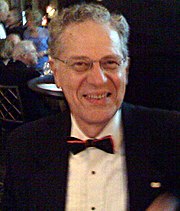Joseph Hooton Taylor Jr.
| Joseph Hooton Taylor Jr. | |
|---|---|
 |
|
| Born |
29 March 1941 Philadelphia, Pennsylvania |
| Nationality | United States |
| Fields | Physics |
| Institutions |
Princeton University University of Massachusetts Amherst Five College Radio Astronomy Observatory |
| Alma mater |
Haverford College Harvard University |
| Known for | Pulsars |
| Notable awards | Dannie Heineman Prize for Astrophysics (1980) Henry Draper Medal (1985) Magellanic Premium (1990) John J. Carty Award (1991) Wolf Prize in Physics (1992) Nobel Prize in Physics (1993) |
Joseph Hooton Taylor Jr. (born March 29, 1941) is an American astrophysicist and Nobel Prize in Physics laureate for his discovery with Russell Alan Hulse of a "new type of pulsar, a discovery that has opened up new possibilities for the study of gravitation."
Taylor was born in Philadelphia to Joseph Hooton Taylor Sr. and Sylvia Evans Taylor, both of whom had Quaker roots for many generations, and grew up in Cinnaminson Township, New Jersey. He attended the Moorestown Friends School in Moorestown Township, New Jersey, where he excelled in math. He received a B.A. in physics at Haverford College in 1963, and a Ph.D. in astronomy at Harvard University in 1968. After a brief research position at Harvard, Taylor went to the University of Massachusetts Amherst, eventually becoming Professor of Astronomy and Associate Director of the Five College Radio Astronomy Observatory. Taylor's thesis work was on lunar occultation measurements. About the time he completed his Ph.D., Jocelyn Bell (who is also a Quaker) discovered the first radio pulsars with a telescope near Cambridge, England.
...
Wikipedia
